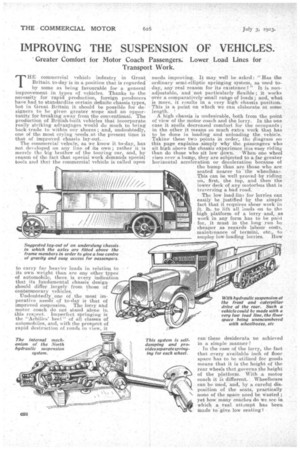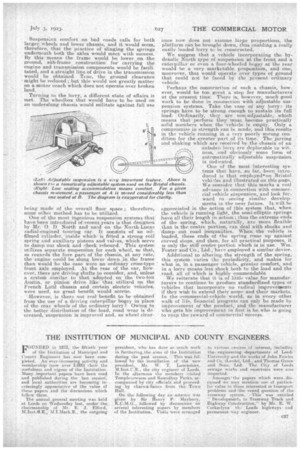IMPROVING THE SUSPENSION OF VEHICLES.
Page 16

Page 17

If you've noticed an error in this article please click here to report it so we can fix it.
' Greater Comfort for Motor Coach Passengers: Lower Load Lines for Transport Work.
THE. commercial vehicle industry in Great, Britain to-day is in a.position that is regarded by some as being favourable for a general improvement in types of vehicles. Thanks to the necessity for •rapid production, foreign producers have had to standardize certain-definite chassis types, but in Great Britain it .should be possible for designers to he given greater scope and., an opportunity for breaking away froth the conventional. The production of British-built vehicles that incorporate really striking ad-Vantages would do Much to bring back .trade to within our shores ; and, undoubtedly; one or the most crying needs at the present time is
that of improvedchassis lay-out— .
The, commercial vehicle; as We know it to-day, has not: developed on any line., of its own; rather itis merely the big brother of the touring car, and, by reason of the fact that special work demands special tools and that the commercial vehicle is called upon
to carry far heavier loads in relation to its own weight than are any other types' of automobile these is every indication that its fundamental chassis .design should differ., largely' from those of contemporary vehicles.
Undoubtedly, one of .the most imperative needs, of to-day is that of improved suspension. The lorry and motor • coach do not stand alone in this respect.. Imperfect Springing is the "Achilles' heel " of all classes of automobiles,. and, with the prospect of rapid destruction of roads in view, it
needs improiing. It may well be asked: "1-12, the ordinary semi-elliptic springing system, as used today, any real reason for its existence? " It is nonadjustable, and not particularly flexible ; it works over a comparatively small range of loads ; and, what is more, it results in a very 'high chassis position.' This is a point On which we can elaborate, at some length.
A high chassis is -undesirable, both from the point of view of the motor coach and the lorry. In the one case it spells decreased comfort for •the occupants ; in the other it means so much extrawork that has to be done in loading and Unloading the vehicle. Takine, these two points in order, the diagram on this page explains simply 'why the pasSengers who sit high above the chassis ekperience less-easy riding than do those who sit low down. When one wheel rises overA bump, they are SObjected to a far greater horizontal acceleration or deceleration becaus,e of the bump than are those. who are seated nearer to the wheelbas3.
This can be wellproved by riding on, first, the top, and then the 1oWer deck of any motorbus that is traversing a bad road.
The low load-line for lorries can easily be justified by the siinpli fact that it requires sheer work in ft. lb: to lift all loads on to the high._ platform of a lorry and, as work in any form has to be pail for, it must in the long ruill be cheaper as regards labour costs, • maintenance of termini, ete to employ low-loading lorries. How
can these desiderata ne achieved in a simple manner?
In the case of the lorry, the fact that every available inch of floor space has to be utilized for goods means that it is the height of the rear wheels that governs the height of the 'platform. With .a motor coach it is different. Wheelboxes can-be used,-and, by a careful disposition of the seats, practically none of the space need be wasted ; Yet how many coach do we. see in which a real attempt has been Made to-give low seating 'd • Suspension comfort on bad roads calls for both larger:wheels and lower chassis, and it would seem, therefore, that the pia-ctiee of slinging the springs underneath both the axles would meet with success. By this means the frame would be lower on the ground, sub-frame construction for carrying the engine and transmission components would be facilitated, and a straight line of drive in the transmission would be obtained. Tine, the ground clearance might be reduced; but this would not greatly matter on a motor coach which does not operate over broken land.
Turning to the lorry, a different state of affairs is met. The wheelbox that would have to be used on an underslung cha.ssis would militate against full use being made of the overall floor space ; therefore, some other method has to be utilized.
One of the most ingenious suspension systems that have been introduced oarecent years is that designed by Mr. 0. I) North and used on the -North-Lucas radial-engined touring ear. It oonaists of an oilfilmed cylinder, inside which' is fitted a strong coil spring and auxiliary pistons and valves, whieh serve to damn out shock and check rebound, This system utilizes separate suspension for each wheel, go that, as regards the fore part of the chassis, at any rate, the engine could be slung lower down in the frame than would be the ease were an ordinary cross-type front axle employed. At the rear of the car, however, there are driving shafts to consider, and, unless a system iimilar to that adopted on the two-ton Austin. or Pinion drive like that utilized on the French Latil chassis and certain electric Vehicles, were used, no great benefit, would accrue.
However, is there not real benefit to be -obtained from the use of a driving caterpillar bogey in place of the rear wheels of the ordinary lorry ? Owing to the better distribution of the load, road wear is decreased, suspension is improved and, as wheel clear
once now does not assume. large proportions, the platform can be brought down, thus enabling a really easily loaded lorry to be constructed.
We suggest that a vehicle incorporating the hydraulic North type of suspension at the front and a caterpillar or even a four-wheeled bogey atthe rear would -be a very marketable proposition, and one, moreover, that would operate over types of ground that could not be faced by the present ordinary vehicle.
'Perhaps the construction of such a chassis, however, would be too great a step for manufacturers at the present tithe. There is, however, much good work to be done in connection with adjustable suspension systems. Take the case of' any lorry: its springs have to be strong enough to sustain its full load. Ordinarily, they are non-adjustable, which means that perforce they must become practically solid members when the -vehicle is empty. Only a compromise in strength can 'ea made, and this results in the vehicle running in a. very poorly sprung condition for the greater part of its time. The jarring and shaking which are received by -the chassis of an unladen lorry are deplorable-to wit. neas, and Obviously •some . form of I automatically adjustable suspension is indicated.
One of the most •interesting system's that have, so fax, -been introduced is that employedion Bristol vehiales and illustrated on this page. Weconsider that this marks a real advance in connection with commercial vehicle suspension, and look forward to • seeing similar developments in -the near future. Itavill be appreciated in the action of this system that, when the Vehicle is running light, the semi-elliptic -springs have all their length an action.; thus the extreme ends of the spring, which, naturally,. are more flexible than is the centre portion, can deal with shocks and 'clamp out road inequalities. When. the vehicle is loaded, these ends of the spring come up against curved stops, and then, for all practical purposes, it is only the stiff centre portim; which-is in use. Wm. Foster-and Co-:; Ltd.', have employed asimilar device.
• Additional to altering the strength of the spring, • Additional to altering the strength of the spring,
this system varies the periodicity, and makes for what is, in a passenger vehicle, greater comfort, and in a lorrymeans less shock both to the load and the read, all of which is highly commendable. We reiterate that it is of little value for manufac turers to continue 'to produce standardized types of vehicles that incorporate no radical improveraents if they wish to extend their scope' and their •markets. In the icommercial-vehicle world, as in every othel walk-of 'life,' financial progress can only be made by imProvement of the product, and the manufacture' who gets his improvement in first is he who is going to reap the-reward of commercial success.














































